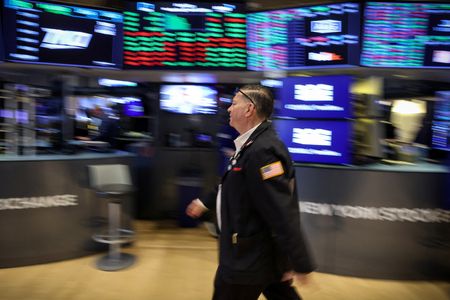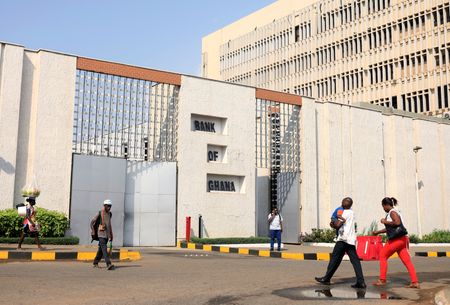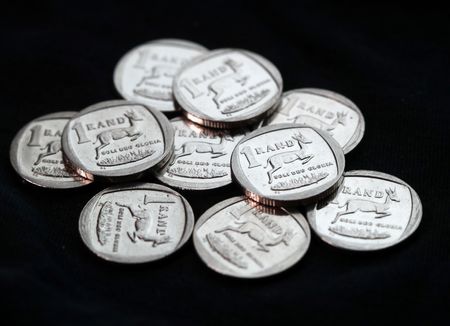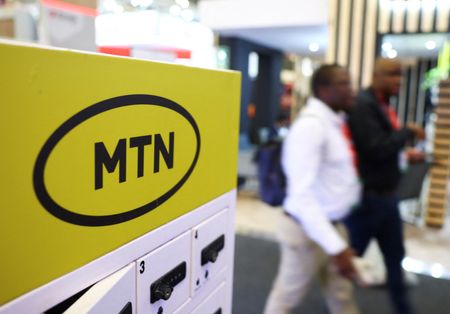By Amanda Cooper, Chibuike Oguh
NEW YORK/LONDON (Reuters) -Global shares edged higher in choppy trading on Tuesday, while safe-haven gold soared to a record peak as markets awaited details of U.S. President Donald Trump’s tariff plans.
Investors are bracing for Trump’s so-called Liberation Day on Wednesday, when he has promised to unveil a massive reciprocal tariff plan.
White House spokeswoman Karoline Leavitt said reciprocal tariffs on countries that impose duties on U.S. goods would take effect immediately after Trump announces them, while a 25% tariff on auto imports will take effect on Thursday.
An announcement is scheduled on Wednesday for 4 p.m. EDT (2000 GMT), Leavitt confirmed on Tuesday.
On Wall Street, the benchmark S&P 500 and the Nasdaq ended higher after losing ground earlier in the session, with gains in consumer discretionary communication services, consumer staples and technology stocks offset by losses in healthcare and financial equities. The Dow finished a shade lower.
“In terms of the upcoming tariff announcement, we still don’t know which countries they’ll be imposed on and what rate. It’s fair to say that the administration might not have the final plan ready as yet,” Deutsche Bank strategist Jim Reid said.
The Dow Jones Industrial Average fell 0.03% to 41,989.96, the S&P 500 rose 0.38% to 5,633.07 and the Nasdaq Composite rose 0.87% to 17,449.89.
European stocks rallied, recovering from the previous day’s bout of profit-taking, particularly in assets that are highly vulnerable to U.S. tariffs.
The benchmark pan-European STOXX 600 index, which rose 5.1% in the first three months of the year, ended up 1%, with technology, industrial and financial stocks leading the way.
Uncertainty is running high. Various measures of stock, bond and currency volatility have risen sharply in the past few days, reflecting the challenge for investors of trading the unknown.
Gold eased after hitting a new record high for a fourth straight session, hitting $3,148.88 per ounce. It fell 0.15% to $3,118.25 an ounce, while U.S. gold futures settled 0.1% lower at $3,146.
Mark Malek, chief investment officer at SiebertNXT, said investors are not just faced with uncertainty from tariffs but they are also worried about the possibility of a looming economic slowdown given weakness in recent data.
Data from the Institute for Supply Management showed U.S. manufacturing contracted in March after growing for two straight months. A separate report from the Labor Department showed U.S. job openings fell in February.
“I can tell you anecdotally that the number of client calls that we’ve been taking lately has increased and it’s not necessarily about tariffs but they are worried about the economy,” Malek said. “They are losing confidence, and that’s investor confidence – which is a tough thing to fight.”
Demand for the safety of Treasuries sent yields lower, with benchmark 10-year note yields falling 8 basis points to 4.165%. In Europe, the yield on benchmark German 10-year Bunds fell 0.3 basis point to 2.679%.
Investor caution toward U.S. assets has resulted in continued pressure on the dollar, which posted its worst first-quarter performance against a basket of currencies in nine years this year, with a drop of nearly 4%.
The Japanese yen held firm, as did the Swiss franc, as traditional safe-haven assets drew demand.
The yen strengthened 0.25% against the greenback to 149.57 per dollar. Against the Swiss franc, the dollar weakened 0.07% to 0.884 franc. The euro was down 0.25% at $1.079.
The dollar index, which measures the greenback against a basket of currencies including the yen and the euro, rose 0.04%.
The Australian dollar strengthened 0.48% versus the greenback to $0.6276. The RBA held rates at 4.1%, having just cut them by a quarter-point in February for the first time in over four years.
Bitcoin gained 3.15% to $85,033.03.
Oil prices edged lower as traders weighed reciprocal tariffs from Trump and his threats to impose secondary tariffs on Russian crude and attack Iran.
Brent futures settled 0.37% lower at $74.49 a barrel. U.S. West Texas Intermediate crude futures fell 0.39% to $71.20.
(Reporting by Kevin Buckland and Chibuike Oguh in New York; Editing by Kim Coghill, Ros Russell, Chris Reese and Matthew Lewis)











